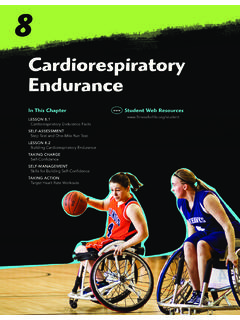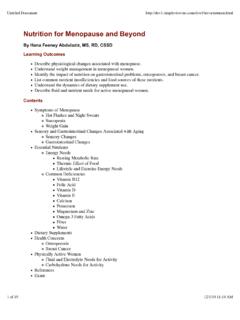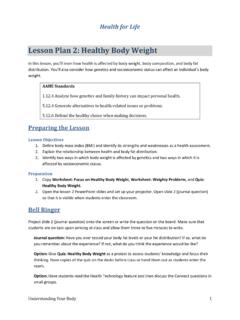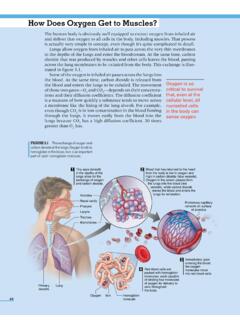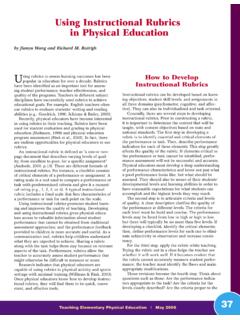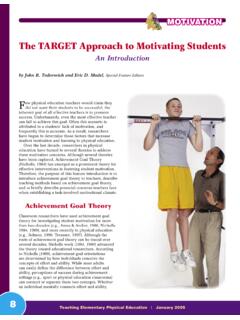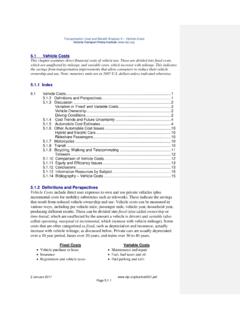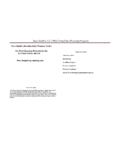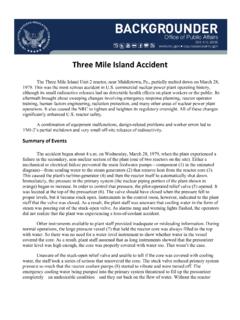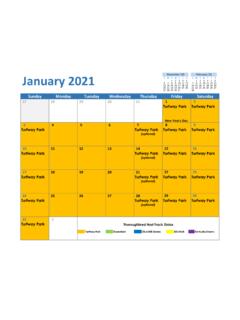Transcription of COOPER 1.5-MILE RUN/ WALK TEST - Human Kinetics
1 193 COOPER RUN/WALK TESTeQUipmenT Measured ( km) distance, ideally on a (400 m) track Physician s scale, stadiometer, or equivalent electronic scale Stopwatch Individual and group data sheets Microsoft Excel or equivalent spreadsheet programLaboratory Activity the group data sheets for this laboratory online at Dimensions for a 400 m (440 yd) m(110 yd)50 m(55 yd)100 m (110 yd)50 m (55 yd)Figure presents a traditional 440-yard or track, in which each straightaway and curve is 110 yards long and half of each length is 55 yards. Distance traveled may differ slightly depending on the track; therefore, when performing timed distances, make sure to understand the various lengths on the track. For example, because a 400 m track is yd ( m) shorter than a 440-yard track, a subject performing a run on a 400 m track must go 14 m (15 yd) beyond 6 laps to complete a mile and a half. Similarly, when 194 performing a 1- mile ( km) Rockport test, one must go 9 m (9 yd) beyond 4 laps to complete a with any performance-based test, the subject should perform a structured warm-up to prepare for the assessment.
2 As a rule, when working with athletes or other fit individuals, devote 5 min to general warm-up activity ( , jogging, cycling, jumping rope), then use 5 min for dynamic stretching ( , high knees, walking lunges, walking knee tucks, butt kicks, inchworms, power skips). With sedentary or untrained individuals, use less rigorous activities ( , leg swings, toe touches). After the warm-up, ensure that the subject clearly understands that the objective of the test is to complete the ( km) distance in as little time as possible. Here is a summary of steps to use when administer-ing this test: COOPER rUn/Walk TesTStep 1: Measure the height and weight of each person being tested and record the results on their individual laboratory data sheets. Measure body mass to the nearest kg and height to the nearest 2: Have each subject complete a structured warm-up of about 10 3: Prior to starting the test, clearly explain that each individual should walk or run the ( km) distance as fast as 4: Start a stopwatch at the same time that the run/walk is 5: When a subject completes the distance, his or her time should be recorded to the nearest second on the laboratory individual data 6: After completing the assessment, each tested individual should per-form a cool-down consisting of slow walking followed by 7: Use the equations presented on the individual data sheet to estimate each individual s V.
3 O2max, then record the seT 1. What is the underlying physiological reason for the relationship found between field tests and laboratory measurements of aerobic power? 2. Based on your results, rank your aerobic fitness in relation to the norms and percentile ranks presented in tables (p. 171) and 3. How did your aerobic fitness results compare with the class averages? 4. Based on the class averages, how would you rate your classmates overall aerobic fitness? 5. What factors associated with this aerobic power test may result in variations in the values estimated for aerobic power?Laboratory Activity Percentile Ranks for Run/Walk Time (min:s)Age (y)20 2930 3940 4950 5960 69 PercentileMenWomenMenWomenMenWomenMenWom enMenWomen909:3410:599:5211:4310:0912:25 11:0913:5812:1015:328010:0811:5610:3812: 5311:0913:3812:0815:1413:2516:467010:491 2:5111:0913:4111:5214:3312:5316:2614:331 8:056011:2713:2511:4914:3312:2515:1713:5 317:1915:2018:525011:5814:1512:2515:1413 :0516:1314:3318:0516:1920:084012:2915:05 12:5315:5613:5017:1115:1419:1017:1920:55 3013:0815:5613:4816:4614:3318:2616:1620: 1718:3922:342013:5817:1114:3318:1815:321 9:4317:3021:5720:1323:551015:1418:3915:5 620:1317:0421:5219:2423:5523:2726:32 Adapted, by permission, from COOPER Institute, Physical tness assessments and norms for adults and law enforcement (Dallas, TX: The COOPER Institute).
4 For more information: Activity the case studies for this laboratory online at Activity Individual Data SheetName or ID number: _____ Tester: _____Date: _____ Time: _____ Sex: M / F (circle one) Age: _____ yHeight: _____ in. _____ cm Weight: _____ lb _____ kgTemperature: _____ F _____ C Relative humidity: _____ %Barometric pressure: _____ mmHgMen VOmax(mlkgmin) ( = bbodymass(kg)time(min)( )) = _____ ml kg 1 min 1 (Equation 1) VOmax(mlkgmin) ( = eexbodymass(kg)t) iime(min) = _____ ml kg 1 min 1 (Equation 2)Women VOmax(mlkgmin)8( = (kg)time(min)( )) = _____ ml kg 1 min 1 (Equation 1) VOmax(mlkgmin) ( = eexbodymass(kg)t) iime(min) = _____ ml kg 1 min 1 (Equation 2)Percentile rank: _____V. O2max classification: _____Laboratory Activity of Testing Outdoor field Indoor field Indoor track Outdoor track Gym Other Footwear Jogging shoe Walking shoe Tennis shoe Basketball shoe Running shoe Cross-trainer Other _____
